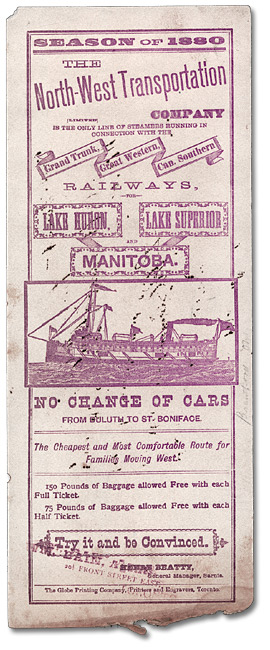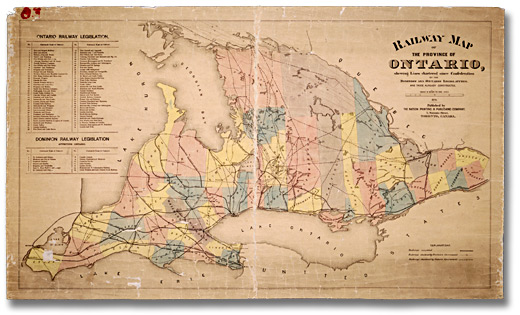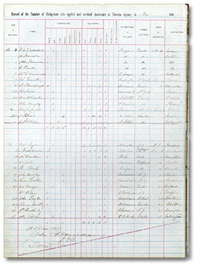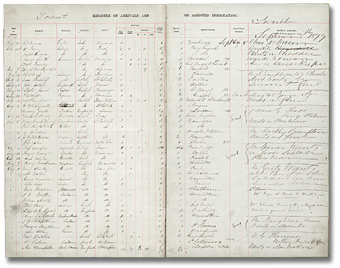
About the Toronto Office Assisted Immigration Registers
The four volumes of assisted immigration registers created by the Toronto Emigrant Office (series RG 11-3) record information about some of the immigrants who arrived in Canada between 1865 and 1883. The registers are a chronological listing of those new immigrants who were assisted by the government to travel to many different destinations across south-central Ontario.
Searching the Database
Enter a search term or terms into one or more fields in the search form.
Alternatively you may press the browse button to choose from a list of all values in that field, for example, all of the surnames in the database. The browse feature will show all variant spellings for names, places, trades etc.
Keep in mind that spellings of names and places recorded in the registers varied greatly and that abbreviations were often used (e.g. Wm. for William; N. Scotian for Nova Scotian). Using the browse feature will reveal variant spellings and abbreviations.
You may “truncate” a search term by using *. For
example searching Fred* in the first name field will return Fred,
Fredrick, Frederick, Freddy etc.
Brief Results

Click to see a larger image
North-West Transportation Company
advertisement, 1880
Reference Code: RG 11-3-0-4
Archives of Ontario
After a search, you will be presented with a summary list of the “hits” for your search. This summary list is not listed in chronological or alphabetical order. Rather, records are displayed in the order in which the entries were recorded in the registers. The entries from volume 1 will preceded entries from volume 2 and so on.
You can click on a Last Name to see the full results for that register entry, or use the click boxes on the left to choose a number of results. Then press the “Show Selected Records” at the bottom of the page to see the detailed search results for your chosen records.
If your search results in only one “hit” the full record will display.
Detailed Search Results
Detailed search results will provide you with full transcriptions for all of the register entries that you selected in your brief search results.
To interpret the information provided about each database entry, see the Key to Transcriptions, or click on a field label to see a description of that field.
About the Toronto Office Assisted Immigration Registers
The four volumes of assisted immigration registers created by the Toronto Emigrant Office (series RG 11-3) record information about some of the immigrants who arrived in Canada between 1865 and 1883. The registers are a chronological listing of those new immigrants who were assisted by the government to travel to many different destinations across south-central Ontario.
The chronological breakdown of the volumes is as follows:
Volume 1: January 3, 1865 to September 20, 1870
Volume 2: September 26, 1870 to July 31, 1873 and October 2 1874 to Dec. 29, 1876
Volume 3: January 1, 1877 to January 31, 1883
Volume 4: May 24, 1873 to Oct. 2, 1874
All four of the volumes are similar; however the kind of information
provided varies slightly from one to the next. Moreover, within
each volume, some entries are more complete than others.
For detailed information on the data recorded in the volumes and transcribed in this database, see the Key to Transcriptions.
To see sample index pages click on the following:
Key to Transcriptions - Toronto Assisted Immigration Registers
Rules Followed in Transcriptions
The spelling of surnames, given names, ships' names, and place names have been transcribed as they appear in the registers. Contractions and short forms have been retained.
All entries were entered and verified. Nonetheless the handwriting in the registers can be difficult to read and on occasion, indecipherable.
Text fields without data have been left blank. When numerical fields were blank, indexers entered a zero to enable researchers to create data totals using computers.
Key to the Database Fields
Names
Names are usually those of an immigrant or the head of a family.
They may also be the name of an agent, interpreter, or someone
bringing children. Not all names in large parties were recorded.
Note: A semi-colon separates multiple surnames or given names that are included in a single entry. If several surnames are recorded in a single entry, semi colons and blanks are used to align the given name with the correct surname.
For example, the name field:
Smith; Graham, W.; R should be read as W. Smith and R. Graham
Note: Given names are often abbreviated: Wm., Fredk., Jno. for William, Frederick or John. Names shortened with a superscript for the last letter are printed in the transcription with an apostrophe.
Note: : “Unknown” If no name was given for a large party of a single ethnicity, “unknown” was entered in the surname column.
Date of Application
This date is the date that the immigrant applied at the Toronto
Office for an assisted fare. If the applicant did not use the
ticket, zeros were used in all numerical columns. In volume 4,
this information was entered in a column titled “Date of
Arrival”.
Nationality
Information was transcribed as recorded in the registers.
Trade
This information appears only in volume 4.
Ship
This field refers to the ship on which the immigrant arrived at
the port of entry.
Landed
This field refers to the port of entry. Quebec City, Halifax,
Portland (Maine) and New York City were the most common.
Destination
This field may refer to the final destination of the emigrant
but it may also be the closest railway station to the emigrant’s
final destination.
Note: Many abbreviations were used, for example: Sus. Bridge for Suspension Bridge. Some place names are spelt incorrectly or differently from the modern standard. Thus names now treated as one word were recorded as two, as in New Market. Names may also be spelled differently at different places in the registers, so that searches based on a place name require some ingenuity.
Railways
This column records the railway taken to the emigrant's final
destination. In most cases, this field was left blank.
Railway names were abbreviated as follows:
- GW (Great Western Railway)
- GT (Grand Trunk)
- N (Northern)
- TGB (Toronto, Grey & Bruce)
- T&N (Toronto and Nipissing)
- CV (Credit Valley)
- H&NW (Hamilton and North Western)

Click to see a larger image
Railway map of province of Ontario showing lines
chartered since Confederation by the Dominion &
Ontario legislatures & those already constructed, 1875.
Reference Code: A-6, Accession 9367
Archives of Ontario
In a few instances, the name entered in the column appears to be that of the steamboat, for instance, the Chicora bound for Niagara.
Male Adults, Female Adults and Children
This numerical data was entered as recorded. A zero was added
if the field was blank. In volume four only, children were separated
into columns for male children, female children, and infants.
Total number of fares
The most common entry is for one individual, but the total may
also be the number of "souls" in a family travelling
under the single name of the father. The total can also be the
total number of a large party of immigrants grouped together in
one entry by the agent.
Reference Code
The reference code is the Archives of Ontario reference code for
this material.
- If you would like to access the database directly, click here.
- Database Home
- A Short History of the Immigrant Office

